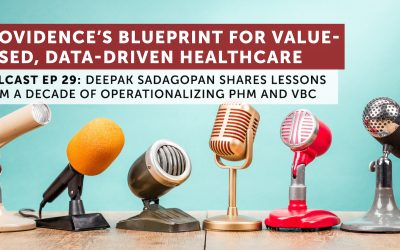Join us for a special dive down the rabbit hole of healthcare and health information technology. Chilmark’s Vice President discusses how the COVID-19 pandemic has delivered an amazing opportunity to drive significant improvements in the way both patients and healthcare organizations are able to access and utilize all the data now being collected. The events of the past year have opened the floodgates for mass public exposure to the many cracks in the American healthcare infrastructure, and the new administration has an incredible opportunity to use this frustration of the masses to drive actual change.
[00:00:01] Oh, hello. I didn’t see you there. Are you tired of overpaying for health care, for only mediocre outcomes? Are you breaking out into a cold sweat whenever you hear the phrase “garbage in, garbage out”? Does true health care interoperability and data liquidity still haunt you and evade your best efforts?
[00:00:22] I’m John Moore and I’m the vice president of Growth Strategy here at Chilmark Research. And if any of these issues are relatable, then we can help you out. New technologies and uses of health care data have been effectively implemented to actually drive you care models and new ways of actually approaching patient care. However, these modernization efforts are being hampered by the age old issue of health care interoperability still not being solved. We still don’t have to deal with it. We still can’t do a lot of things that we expect to be able to do with this data. And to top it off, as we look to move towards value–based care, what is value? We don’t have a definition for this yet. We’re still overpaying for health care relative to our developed nation peers, but we don’t have a good definition of value, care means. And so we’re sitting here and we’re looking at the system. And without any true market forces in play, we’re just twiddling their thumbs, recognizing that what we have now is most certainly not it. But we do know is that the way that our health care system has evolved has greatly contributed to this problem because we have a very fractured, very siloed way of keeping track of a patient’s medical history.
[00:01:31] This makes it incredibly difficult for either a patient or provider to actually access a true comprehensive longitudinal medical history for an individual that lets them treat them as a whole patient as opposed to an individual that’s presenting with an acute condition. This obviously complicates matters because there’s not a comprehensive understanding of how this patient should best be treated factor into that average medical literacy, and you can only imagine how frustrating this is on the consumer end as they try to take better control of their own well-being. And they’re constantly being blocked left, right and center. Why don’t we just take a walk and you can follow along so we can dig into this a bit more. Let’s go. If we’re going to talk about value in health care, we just take a step back and really understand and look at what is truly contributing to health care costs and outcomes, we’ve been sold this narrative that doctors and hospitals and the care providers are essential to providing care, which is true in acute situations, but the bill of goods otherwise, I mean, they only account for about 20 percent of health outcomes are other life decisions. And our structural and socioeconomic factors play a much bigger role in our health outcomes than any care that we actually receive. How do we start applying this in a health care setting so that people feel like we are actually getting the value that we deserve out of modern technologies and modern medicine? This info graphic does a great job of revealing that American citizens have been exposed to a lot more than just the virus.
[00:03:03] Over the past year, we were exposed to exactly how fundamentally broken our health care infrastructure is because every single one of these social determinants completely broke the economy and the country for at least a little while. So where does this all actually start to tie back in with the health care system? Because obviously the social determinants I just mentioned, a lot of them, there’s no direct connection. But what we’re seeing is that we’re starting to have all these new data feeds. A new outside source is trying to pump their data directly into the electronic health record, which in theory is fantastic, but in practice is miserable failure. We have had decades of interoperability issues in health care, and those are only just starting to be resolved. But the addition of new solutions and new data feeds is just complicating matters because everybody’s building off of different standards. There is a light at the tunnel, however. We’ve been seeing significant concerted efforts from the government over the last few administrations to encourage and facilitate greater interoperability across the health care system so that providers and vendors stop monopolizing patient data. This is our information. This is our data. We should have the final say in how it’s used.
[00:04:10] We shouldn’t have to pay twenty five dollars to get a print of it, like we’re paying for the services, give us our data. We want our data and we want it now. This is what this all produces. This is where we end up this crazy, chaotic mess of it, solutions and potential for us to actually change health care. It’s going to take a while. We have a lot to do still. And there’s so many different moving pieces right now is all this is getting sorted out and there’s massive consolidation. There’s money flying around everywhere right now. Massive investments, big massive acquisitions in the billions of dollars like this is just out of control at this point. And it’s great because there is a lot of opportunity here, but there’s a massive amount of crap that needs to get sorted out. First, we need to actually figure out how these things play together, will play together nicely. And again, this comes back to defining value. How do we define value in health care spending? Billions of dollars on administrative junk and we come on, we can do better if you want to figure out how to kind of navigate this crazy world that we’re living in today with modern technology, modern medicine, modern science, please come to us here, Chilmark Research, because we can help you try to make sense of this. That’s our job here, looking at this and teasing out the signal from the noise.




0 Comments